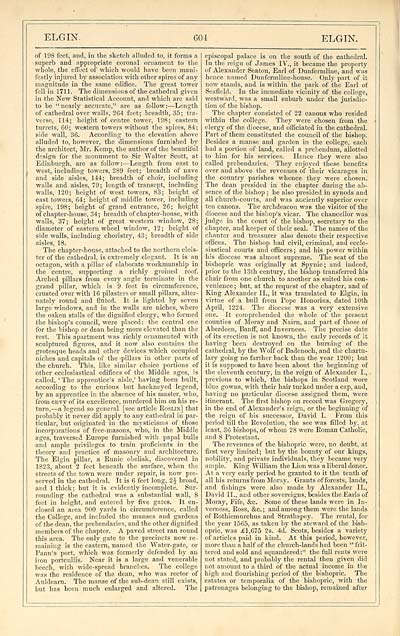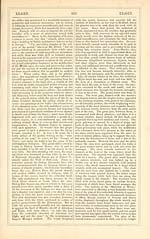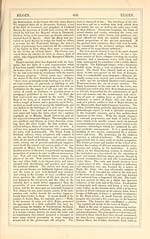Download files
Complete book:
Individual page:
Thumbnail gallery: Grid view | List view

ELGIN-
604
ELGIN.
of 198 feet, and, in the sketch alluded to, it forms a
superb and appropriate coronal ornament to the
whole, the effect of which would have been mani-
festly injured by association with other spires of any
magnitude in the same edifice. The great tower
fell in 1711. The dimensions of the cathedral given
in the New Statistical Account, and which are said
to be "nearly accurate," are as follow: — Length
of cathedral over walls, 264 feet; breadth, 35; tra-
verse, 114; height of centre tower, 198; eastern
turrets, 60 ; western towers without the spires, 84 ;
side wall, 36. According to the elevation above
alluded to, however, the dimensions furnished by
the architect, Mr. Kemp, the author of the beautiful
design for the monument to Sir Walter Scott, at
Edinburgh, are as follow: — Length from east to
west, including towers, 289 feet; breadth of nave
and side aisles, 144; breadth of choir, including
walls and aisles, 79; length of transept, including
walls, 120; height of west towers, 83; height of
east towers, 64; height of middle tower, including
spire, 198; height of grand entrance, 26; height
of chapter-house, 34; breadth of chapter-house, with
walls, 37; height of great western window, 28;
diameter of eastern wheel window, 12 ; height of
side walls, including choristry, 43; breadth of side
aisles, 18.
The chapter-house, attached to the northern clois-
ter of the cathedral, is extremely elegant. It is an
octagon, with a pillar of elaborate workmanship in
the centre, supporting a richly groined roof.
Arched pillars from every angle terminate in the
grand pillar, which is 9 feet in circumference,
crusted over with 1 6 pilasters or small pillars, alter-
nately round and fluted. It is lighted by seven
large windows, and in the walls are niches, where
the oaken stalls of the dignified clergy, who formed
the bishop's council, were placed: the central one
for the bishop or dean being more elevated than the
rest. This apartment was richly ornamented with
sculptured figures, and it now also contains the
grotesque heads and other devices which occupied
niches and capitals of the pillars in other parts of
the church. This, like similar choice portions of
other ecclesiastical edifices of the Middle ages, is
called, ' The apprentice's aisle,' having been built,
according to the curious but hackneyed legend,
by an apprentice in the absence of his master, who,
from envy of its excellence, murdered him on his re-
turn, — a legend so general [see article Rosltn] that
probably it never did apply to any cathedral in par-
ticular, but originated in the mysticisms of those
incorporations of free-masons, who, in the Middle
ages, traversed Europe furnished with papal bulls
and ample privileges to train proficients in the
theory and practice of masonry and architecture.
The Elgin pillar, a Runic obelisk, discovered in
1823, about 2 feet beneath the surface, when the
streets of the town were under repair, is now pre-
served in the cathedral. It is 6 feet long, 2 J broad,
and 1 thick; but it is evidently incomplete. Sur-
rounding the cathedral was a substantial wall, 8
feet in height, and entered by five gates. It en-
closed an area 900 yards in circumference, called
the College, and included the manses and gardens
of the dean, the prebendaries, and the other dignified
members of the chapter. A paved street ran round
this area. The only gate to the precincts now re-
maining is the eastern, named the Water-gate, or
Pann's port, which was formerly defended by an
iron portcullis. Near it is a large and venerable
beech, with wide-spread branches. The college
was the residence of the dean, who was rector of
Auldearn. The manse of the sub-dear, still exists,
but lias been much enlarged and altered. The
episcopal palace is on the south of the cathedral.
In the reign of James IV., it became the property
of Alexander Seaton, Earl of Dunfermline, and was
hence named Dunfermline-house. Only part of it
now stands, and is within the park of the Earl of
Seafield. In the immediate vicinity of the college,
westward, was a small suburb under the jurisdic-
tion of the bishop.
The chapter consisted of 22 canons who resided
within the college. They were chosen from the
clergy of the diocese, and officiated in the cathedral.
Part of them constituted the council of the bishop.
Besides a manse and garden in the college, each
had a portion of land, called a prebendum, allotted
to him for his services. Hence they were also
called prebendaries. They enjoyed these benefits
over and above the revenues of their vicarages in
the country parishes whence they were chosen.
The dean presided in the chapter during the ab-
sence of the bishop ; he also presided in synods and
all church-courts, and was anciently superior over
ten canons. The archdeacon was the visitor of the
diocese and the bishop's vicar. The chancellor was
judge in the court of the bishop, secretary to the
chapter, and keeper of their seal. The names of the
chanter and treasurer also denote their respective
offices. The bishop had civil, criminal, and eccle-
siastical courts and officers ; and his power within
his diocese was almost supreme. The seat of the
bishopric was originally at Spynie; and indeed,
prior to the 13th century, the bishop transferred his
chair from one church to another as suited his con-
venience ; but, at the request of the chapter, and of
King Alexander II., it was translated to Elgin, in
virtue of a bull from Pope Honorius, dated 10th
April, 1224. The diocese was a veiy extensive
one. It comprehended the whole of the present
counties of Moray and Nairn, and part of those of
Aberdeen, Banff, and Inverness. The precise date
of its erection is not known, the early records of it
having been destroyed on the burning of the
cathedral, by the Wolf of Badenoch, and the chartu-
lary going no farther back than the year 1200; but
it is supposed to have been about the beginning of
the eleventh century, in the reign of Alexander I.,
previous to which, the bishops in Scotland wore
blue gowns, with their hair tucked under a cap, and,
having no particular diocese assigned them, were
itinerant. The first bishop on record was Gregory,
in the end of Alexander's reign, or the beginning of
the reign of his successor, David I. From this
period till the Revolution, the see was filled by, at
least, 36 bishops, of whom 28 were Roman Catholic,
and 8 Protestant.
The revenues of the bishopric were, no doubt, at
first very limited ; but by the bounty of our kings,
nobility, and private individuals, they became very
ample. King William the Lionw r as a liberal donor.
At a veiy early period he granted to it the tenth of
all his returns from Moray. Grants of forests, lands,
and fishings were also made by Alexander II.,
David II., and other sovereigns, besides the Earls of
Moray, Fife, &c. Some of these lands were in In-
verness, Ross, &c. ; and among them were the lands
of Rothiemurchus and Strathspey. The rental, for
the year 1565, as taken by the steward of the bish-
opric, was £\ ,675 2s. 4d. Scots, besides a variety
of articles paid in kind. At this period, however,
more than a half of the church-lands had been " frit-
tered and sold and squandered:" the full rents were
not stated, and probably the rental then given did
not amount to a third of the actual income in the
high and flourishing period of the bishopric. The
estates or temporalia of the bishopric, with the
patronages belonging to the bishop, remained after
604
ELGIN.
of 198 feet, and, in the sketch alluded to, it forms a
superb and appropriate coronal ornament to the
whole, the effect of which would have been mani-
festly injured by association with other spires of any
magnitude in the same edifice. The great tower
fell in 1711. The dimensions of the cathedral given
in the New Statistical Account, and which are said
to be "nearly accurate," are as follow: — Length
of cathedral over walls, 264 feet; breadth, 35; tra-
verse, 114; height of centre tower, 198; eastern
turrets, 60 ; western towers without the spires, 84 ;
side wall, 36. According to the elevation above
alluded to, however, the dimensions furnished by
the architect, Mr. Kemp, the author of the beautiful
design for the monument to Sir Walter Scott, at
Edinburgh, are as follow: — Length from east to
west, including towers, 289 feet; breadth of nave
and side aisles, 144; breadth of choir, including
walls and aisles, 79; length of transept, including
walls, 120; height of west towers, 83; height of
east towers, 64; height of middle tower, including
spire, 198; height of grand entrance, 26; height
of chapter-house, 34; breadth of chapter-house, with
walls, 37; height of great western window, 28;
diameter of eastern wheel window, 12 ; height of
side walls, including choristry, 43; breadth of side
aisles, 18.
The chapter-house, attached to the northern clois-
ter of the cathedral, is extremely elegant. It is an
octagon, with a pillar of elaborate workmanship in
the centre, supporting a richly groined roof.
Arched pillars from every angle terminate in the
grand pillar, which is 9 feet in circumference,
crusted over with 1 6 pilasters or small pillars, alter-
nately round and fluted. It is lighted by seven
large windows, and in the walls are niches, where
the oaken stalls of the dignified clergy, who formed
the bishop's council, were placed: the central one
for the bishop or dean being more elevated than the
rest. This apartment was richly ornamented with
sculptured figures, and it now also contains the
grotesque heads and other devices which occupied
niches and capitals of the pillars in other parts of
the church. This, like similar choice portions of
other ecclesiastical edifices of the Middle ages, is
called, ' The apprentice's aisle,' having been built,
according to the curious but hackneyed legend,
by an apprentice in the absence of his master, who,
from envy of its excellence, murdered him on his re-
turn, — a legend so general [see article Rosltn] that
probably it never did apply to any cathedral in par-
ticular, but originated in the mysticisms of those
incorporations of free-masons, who, in the Middle
ages, traversed Europe furnished with papal bulls
and ample privileges to train proficients in the
theory and practice of masonry and architecture.
The Elgin pillar, a Runic obelisk, discovered in
1823, about 2 feet beneath the surface, when the
streets of the town were under repair, is now pre-
served in the cathedral. It is 6 feet long, 2 J broad,
and 1 thick; but it is evidently incomplete. Sur-
rounding the cathedral was a substantial wall, 8
feet in height, and entered by five gates. It en-
closed an area 900 yards in circumference, called
the College, and included the manses and gardens
of the dean, the prebendaries, and the other dignified
members of the chapter. A paved street ran round
this area. The only gate to the precincts now re-
maining is the eastern, named the Water-gate, or
Pann's port, which was formerly defended by an
iron portcullis. Near it is a large and venerable
beech, with wide-spread branches. The college
was the residence of the dean, who was rector of
Auldearn. The manse of the sub-dear, still exists,
but lias been much enlarged and altered. The
episcopal palace is on the south of the cathedral.
In the reign of James IV., it became the property
of Alexander Seaton, Earl of Dunfermline, and was
hence named Dunfermline-house. Only part of it
now stands, and is within the park of the Earl of
Seafield. In the immediate vicinity of the college,
westward, was a small suburb under the jurisdic-
tion of the bishop.
The chapter consisted of 22 canons who resided
within the college. They were chosen from the
clergy of the diocese, and officiated in the cathedral.
Part of them constituted the council of the bishop.
Besides a manse and garden in the college, each
had a portion of land, called a prebendum, allotted
to him for his services. Hence they were also
called prebendaries. They enjoyed these benefits
over and above the revenues of their vicarages in
the country parishes whence they were chosen.
The dean presided in the chapter during the ab-
sence of the bishop ; he also presided in synods and
all church-courts, and was anciently superior over
ten canons. The archdeacon was the visitor of the
diocese and the bishop's vicar. The chancellor was
judge in the court of the bishop, secretary to the
chapter, and keeper of their seal. The names of the
chanter and treasurer also denote their respective
offices. The bishop had civil, criminal, and eccle-
siastical courts and officers ; and his power within
his diocese was almost supreme. The seat of the
bishopric was originally at Spynie; and indeed,
prior to the 13th century, the bishop transferred his
chair from one church to another as suited his con-
venience ; but, at the request of the chapter, and of
King Alexander II., it was translated to Elgin, in
virtue of a bull from Pope Honorius, dated 10th
April, 1224. The diocese was a veiy extensive
one. It comprehended the whole of the present
counties of Moray and Nairn, and part of those of
Aberdeen, Banff, and Inverness. The precise date
of its erection is not known, the early records of it
having been destroyed on the burning of the
cathedral, by the Wolf of Badenoch, and the chartu-
lary going no farther back than the year 1200; but
it is supposed to have been about the beginning of
the eleventh century, in the reign of Alexander I.,
previous to which, the bishops in Scotland wore
blue gowns, with their hair tucked under a cap, and,
having no particular diocese assigned them, were
itinerant. The first bishop on record was Gregory,
in the end of Alexander's reign, or the beginning of
the reign of his successor, David I. From this
period till the Revolution, the see was filled by, at
least, 36 bishops, of whom 28 were Roman Catholic,
and 8 Protestant.
The revenues of the bishopric were, no doubt, at
first very limited ; but by the bounty of our kings,
nobility, and private individuals, they became very
ample. King William the Lionw r as a liberal donor.
At a veiy early period he granted to it the tenth of
all his returns from Moray. Grants of forests, lands,
and fishings were also made by Alexander II.,
David II., and other sovereigns, besides the Earls of
Moray, Fife, &c. Some of these lands were in In-
verness, Ross, &c. ; and among them were the lands
of Rothiemurchus and Strathspey. The rental, for
the year 1565, as taken by the steward of the bish-
opric, was £\ ,675 2s. 4d. Scots, besides a variety
of articles paid in kind. At this period, however,
more than a half of the church-lands had been " frit-
tered and sold and squandered:" the full rents were
not stated, and probably the rental then given did
not amount to a third of the actual income in the
high and flourishing period of the bishopric. The
estates or temporalia of the bishopric, with the
patronages belonging to the bishop, remained after
Set display mode to: Large image | Transcription
Images and transcriptions on this page, including medium image downloads, may be used under the Creative Commons Attribution 4.0 International Licence unless otherwise stated. ![]()
| Gazetteers of Scotland, 1803-1901 > Imperial gazeteer of Scotland, or, Dictionary of Scottish topography > Volume 1 > (732) Page 604 |
|---|
| Permanent URL | https://digital.nls.uk/97467914 |
|---|
| Description | Volume I: Aan-Gordon. |
|---|---|
| Attribution and copyright: |
|

